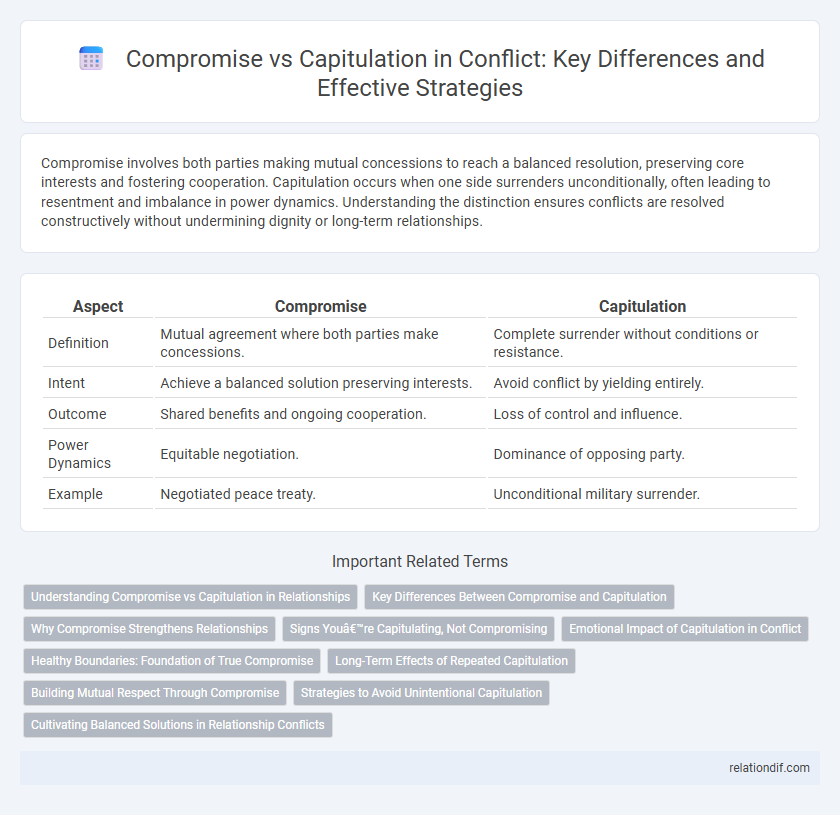Compromise involves both parties making mutual concessions to reach a balanced resolution, preserving core interests and fostering cooperation. Capitulation occurs when one side surrenders unconditionally, often leading to resentment and imbalance in power dynamics. Understanding the distinction ensures conflicts are resolved constructively without undermining dignity or long-term relationships.
Table of Comparison
| Aspect | Compromise | Capitulation |
|---|---|---|
| Definition | Mutual agreement where both parties make concessions. | Complete surrender without conditions or resistance. |
| Intent | Achieve a balanced solution preserving interests. | Avoid conflict by yielding entirely. |
| Outcome | Shared benefits and ongoing cooperation. | Loss of control and influence. |
| Power Dynamics | Equitable negotiation. | Dominance of opposing party. |
| Example | Negotiated peace treaty. | Unconditional military surrender. |
Understanding Compromise vs Capitulation in Relationships
Compromise in relationships involves mutual concessions where both parties maintain their core values while seeking a balanced solution, fostering respect and cooperation. Capitulation occurs when one party yields entirely to the other's demands, often resulting in resentment and imbalance. Recognizing the distinction between healthy compromise and harmful capitulation is essential for sustaining trust and equality in interpersonal dynamics.
Key Differences Between Compromise and Capitulation
Compromise involves mutual concessions where conflicting parties reach a balanced agreement preserving core interests, while capitulation denotes one side's complete surrender, abandoning key demands. In compromise, both parties maintain partial autonomy and achieve a sustainable resolution, whereas capitulation results in dominance by one party and loss of influence by the other. Understanding these distinctions is crucial for effective conflict resolution strategies and maintaining long-term relationships.
Why Compromise Strengthens Relationships
Compromise strengthens relationships by fostering mutual respect and understanding, allowing conflicting parties to find common ground without sacrificing core values. Unlike capitulation, which often breeds resentment and imbalance, compromise encourages active collaboration and shared problem-solving. This cooperative approach builds trust, enhances communication, and creates a foundation for long-term stability in relationships.
Signs You’re Capitulating, Not Compromising
Signs you're capitulating rather than compromising include consistently sacrificing your core values and needs to appease the other party, feeling resentful or powerless after agreements, and facing persistent one-sided concessions without mutual benefit. In capitulation, communication often becomes one-dimensional, with little room for negotiation or respect for your boundaries. Recognizing these signs helps distinguish true compromise, which balances interests, from capitulation that leads to domination or loss of agency.
Emotional Impact of Capitulation in Conflict
Capitulation in conflict often triggers profound emotional distress, including feelings of defeat, helplessness, and loss of dignity. Unlike compromise, which allows for mutual agreement and preservation of some interests, capitulation can lead to resentment and long-term psychological scars. This emotional turmoil can hinder relationship repair and exacerbate ongoing tensions.
Healthy Boundaries: Foundation of True Compromise
Healthy boundaries serve as the foundation of true compromise by ensuring that each party's core values and needs are respected during conflict resolution. Compromise involves mutual concessions that maintain dignity and autonomy, whereas capitulation denotes surrender without regard for one's principles. Establishing clear, healthy boundaries prevents resentment and promotes sustainable agreements based on balance and fairness.
Long-Term Effects of Repeated Capitulation
Repeated capitulation in conflict situations often leads to the erosion of a party's credibility and bargaining power, resulting in weakened influence over future negotiations. Such patterns can foster dependency and reduce the ability to advocate effectively for interests, undermining long-term strategic goals. Over time, this dynamic increases vulnerability to exploitation and diminishes the likelihood of achieving sustainable, mutually beneficial agreements.
Building Mutual Respect Through Compromise
Building mutual respect through compromise requires recognizing the legitimate interests of all parties involved and finding solutions that address core concerns without sacrificing fundamental values. Compromise fosters trust and cooperation by encouraging open communication, empathy, and a willingness to make concessions for the greater good. It strengthens relationships and promotes sustainable conflict resolution, distinguishing it from capitulation, which often entails surrendering principles and undermines long-term respect.
Strategies to Avoid Unintentional Capitulation
Effective strategies to avoid unintentional capitulation in conflict include clearly defining non-negotiable principles and maintaining open communication channels to ensure mutual understanding. Establishing firm boundaries and regularly assessing the impact of concessions helps preserve core objectives without undermining strategic positions. Training leaders in negotiation tactics and recognizing subtle pressure tactics reduces the risk of conceding crucial demands unintentionally.
Cultivating Balanced Solutions in Relationship Conflicts
Cultivating balanced solutions in relationship conflicts requires distinguishing compromise from capitulation by ensuring mutual respect and equitable concessions. Effective conflict resolution combines active listening with empathetic communication to foster trust and shared understanding. Prioritizing collaborative problem-solving over unilateral surrender strengthens relational resilience and long-term harmony.
Compromise vs capitulation Infographic

 relationdif.com
relationdif.com